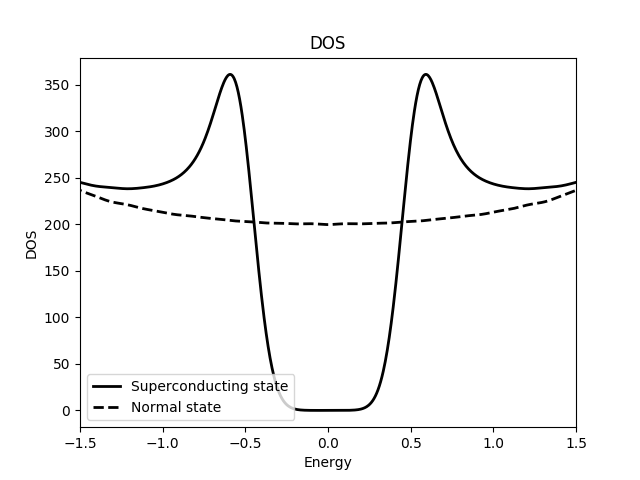Hamiltonian
\(H = -\mu\sum_{\mathbf{i}}\left(c_{\mathbf{i}\uparrow}^{\dagger}c_{\mathbf{i}\uparrow} - c_{\mathbf{i}\downarrow}c_{\mathbf{i}\downarrow}^{\dagger}\right) + t\sum_{\langle\mathbf{i}\mathbf{j}\rangle}\left(c_{\mathbf{i}\uparrow}^{\dagger}c_{\mathbf{j}\uparrow} - c_{\mathbf{i}\downarrow}c_{\mathbf{j}\downarrow}^{\dagger}\right) + \sum_{\mathbf{i}}\left(\Delta c_{\mathbf{i}\uparrow}^{\dagger}c_{\mathbf{i}\downarrow}^{\dagger} + \Delta^{*}c_{\mathbf{i}\downarrow}c_{\mathbf{i}\uparrow}\right)\)
Note
For ordinary s-wave superconductivity, only spin-up electrons and spin-down holes are considered. This is why the Hamiltonian above has up-spin indices on the electron operators (creation if it is to the left and annihilation if it is to the right) and down-spin indices on the hole operators (annihilation if it is to the left and creation if it is to the right).
By introducing the notation \(a_{\mathbf{i}0} = c_{\mathbf{i}\uparrow}\) and \(a_{\mathbf{i}1} = c_{\mathbf{i}\downarrow}^{\dagger}\), we can rewrite the Hamiltonian as
\(H = -\mu\sum_{\mathbf{i}}\left(a_{\mathbf{i}0}^{\dagger}a_{\mathbf{i}0} - a_{\mathbf{i}1}^{\dagger}a_{\mathbf{i}1}\right) + t\sum_{\langle\mathbf{i}\mathbf{j}\rangle}\left(a_{\mathbf{i}0}^{\dagger}a_{\mathbf{j}0} - a_{\mathbf{i}1}^{\dagger}a_{\mathbf{j}1}\right) + \sum_{\mathbf{i}}\left(\Delta a_{\mathbf{i}0}^{\dagger}a_{\mathbf{i}1} + \Delta^{*}a_{\mathbf{i}1}^{\dagger}a_{\mathbf{i}0}\right)\) This is on the same form as an ordinary bilinear Hamiltonian and therefore allows us to solve the problem as such.
Code
#include "TBTK/PropertyExtractor/Diagonalizer.h"
#include <complex>
using namespace std;
using namespace TBTK;
using namespace Visualization::MatPlotLib;
complex<double> i(0, 1);
int main(){
const unsigned int SIZE_X = 30;
const unsigned int SIZE_Y = 30;
const double t = -1;
const double mu = -2;
Plotter plotter;
plotter.setBoundsX(-1.5, 1.5);
for(unsigned int n = 0; n < 2; n++){
double Delta;
if(n == 0)
Delta = 0.5;
else
Delta = 0;
for(unsigned int x = 0; x < SIZE_X; x++){
for(unsigned int y = 0; y < SIZE_Y; y++){
for(unsigned int ph = 0; ph < 2; ph++){
-mu*(1. - 2*ph),
{x, y, ph},
{x, y, ph}
);
if(x+1 < SIZE_X){
t*(1. - 2*ph),
{x+1, y, ph},
{x, y, ph}
) + HC;
}
if(y+1 < SIZE_Y){
t*(1. - 2*ph),
{x, y+1, ph},
{x, y, ph}
) + HC;
}
}
Delta,
{x, y, 1},
{x, y, 0}
) + HC;
}
}
const double LOWER_BOUND = -2;
const double UPPER_BOUND = 2;
const unsigned int RESOLUTION = 1000;
propertyExtractor.setEnergyWindow(
LOWER_BOUND,
UPPER_BOUND,
RESOLUTION
);
const double SMOOTHING_SIGMA = 0.1;
const unsigned int SMOOTHING_WINDOW = 201;
dos = Smooth::gaussian(dos, SMOOTHING_SIGMA, SMOOTHING_WINDOW);
if(n == 0){
plotter.plot(
dos,
{
{"linestyle", "-"},
{"color", "black"},
{"label", "Superconducting state"}
}
);
}
else{
plotter.plot(
dos,
{
{"linestyle", "--"},
{"color", "black"},
{"label", "Normal state"}
}
);
}
}
plotter.save("figures/DOS.png");
}
Output


